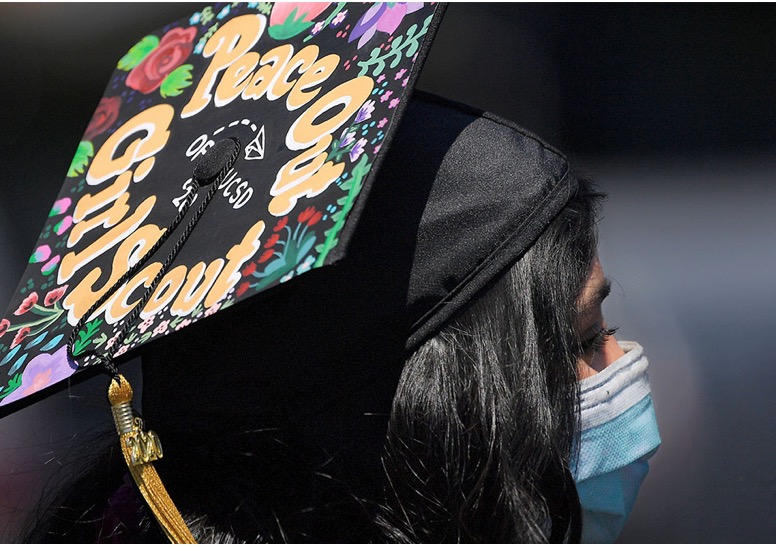CommentsEDUCATION WATCH - Why should you need a high school degree to go to university in California?
In 2020 and 2021, the state’s public schools ditched their students, shutting down K-12 campuses for over a year and providing irregular and ineffective online lessons. Since then, educational leaders have often failed to acknowledge, and done too little to compensate for, all the learning loss—which is why average California eighth graders now do math at a fifth-grade level.
And with public schools just trying to survive chronic absenteeism, teacher resignations, political controversy, and historic enrollment declines (270,000 kids statewide since March 2020), there’s little chance of restoring the system and its standards anytime soon.
Rather than confront this historic educational failure, the state of California has sought to cover it up—by eliminating testing, turning Ds and Fs into passing grades, and reducing graduation requirements, which were already among the most meager in the country (we only require two years of math).
Add it all up (if you have the math skills), and California high school diplomas no longer mean that much.
Which is why our state university systems should stop requiring them for admission.
You read that right. The University of California and California State University systems should immediately drop their admission requirement that students graduate from high school—for at least the rest of this decade.
Anyone who attended school in California during the pandemic and who wants a seat in one of those systems should get one, regardless of high school completion.
The notion may seem crazy but it is not novel. You already can attend California community colleges without a diploma or GED. And some elite colleges, including Harvard, will admit students without high school degrees.
But California’s four-year public universities still require a high school degree—maintaining a status quo that wasn’t working all that well before the pandemic.
Now, unfortunately, UC and CSU are putting more emphasis than ever on the grades and work students do in the state’s failing high schools. CSU is considering adding a required quantitative course and raising their standards to 16 required high school courses, while 11 of the 13 factors UC considers in reviewing applications are entirely tied to high school performance.
And they are unapologetic about it. Indeed, these institutions are bragging about their new high-school-heavy admissions policies, because it is part of California’s self-righteous rush to eliminate standardized testing in education.
The UC and CSU systems, by getting rid of the SAT and ACT, and the state, in eliminating the high school exit exam, have claimed to be promoting inclusion, since standardized test results often are biased by race and class. But this shift away from testing has a dark side. It means that high schools—the same high schools that have lost track of as many of the one in 10 kids who have departed their rolls—become even more important.
You don’t have to be a cynic to see the cynicism in this test-free, high-school-centric approach. By eliminating tests that might show how poorly schools and students are performing, the educational system is avoiding accountability, protecting itself, and shifting the costs of its failures onto pandemic-era students.
Worse still, the whole thing is being justified by a supposed commitment to equity, and by educational officials who have denied the full reality of the current crisis.
So, what is that reality? Part of the scandal in pandemic-era education is that the schools and the state have made that question impossible to answer. The education establishment, which has struggled to build a robust and effective student data system, hasn’t kept close enough tabs on students to provide a full and accurate picture
But one near-certain truth is that the most vulnerable students—homeless students, students with disabilities, and students who are children of immigrants, or of color, or from poorer places—have been the most likely to be left behind these past two years. So, if equity is to mean anything in California education, those students deserve the right to walk into a public university, regardless of how they did in high school.
Giving those students a real chance to stick in our universities will be hard. It will demand new ways of assessing high school dropouts to see if they would fit better at UC or CSU. It will require more kinds of support, more counseling, and more resources to keep them there. (CSU’s Graduation Initiative 2025, which has had some success in keeping students in college, offers the beginnings of such a model.)
It also may require the federal government to step in and exempt California from requirements that tie federal financial aid to high school degrees. And it will force the state to shift fiscal priorities, forgoing one-time giveaways like gas tax rebates and embracing the type of longer-term educational investments that are challenging under our complicated budget system.
But if more students whose educations were disrupted by the pandemic can get to college, and get through college, they won’t be the only winners. Colleges, suffering declines in enrollment during the pandemic, will see more students. And California as a whole will be better off.
Top of Form
Indeed, decoupling high school graduation from college attendance could prove to be more than a short-term experiment. California has been producing far fewer college graduates than its economy requires. If California wanted to be more ambitious, it could combine a “no high school degree, no problem” policy with a larger program to help the millions of adults who have dropped out of college to return and get their degrees.
This approach is what real fairness would look like—especially for the young Californians our education system has left in the lurch.
(Joe Mathews writes the Connecting California column for Zócalo Public Square where this was first published.)






